The largest animals in the world present an interesting array and creatures, looking not just at height and weight but also relative size for their species. For example, the giant huntsman spider or ostrich may pale in comparison to a blue whale, but they are titans within their ecological niche, and thus their impact and gravitas cannot be ignored.
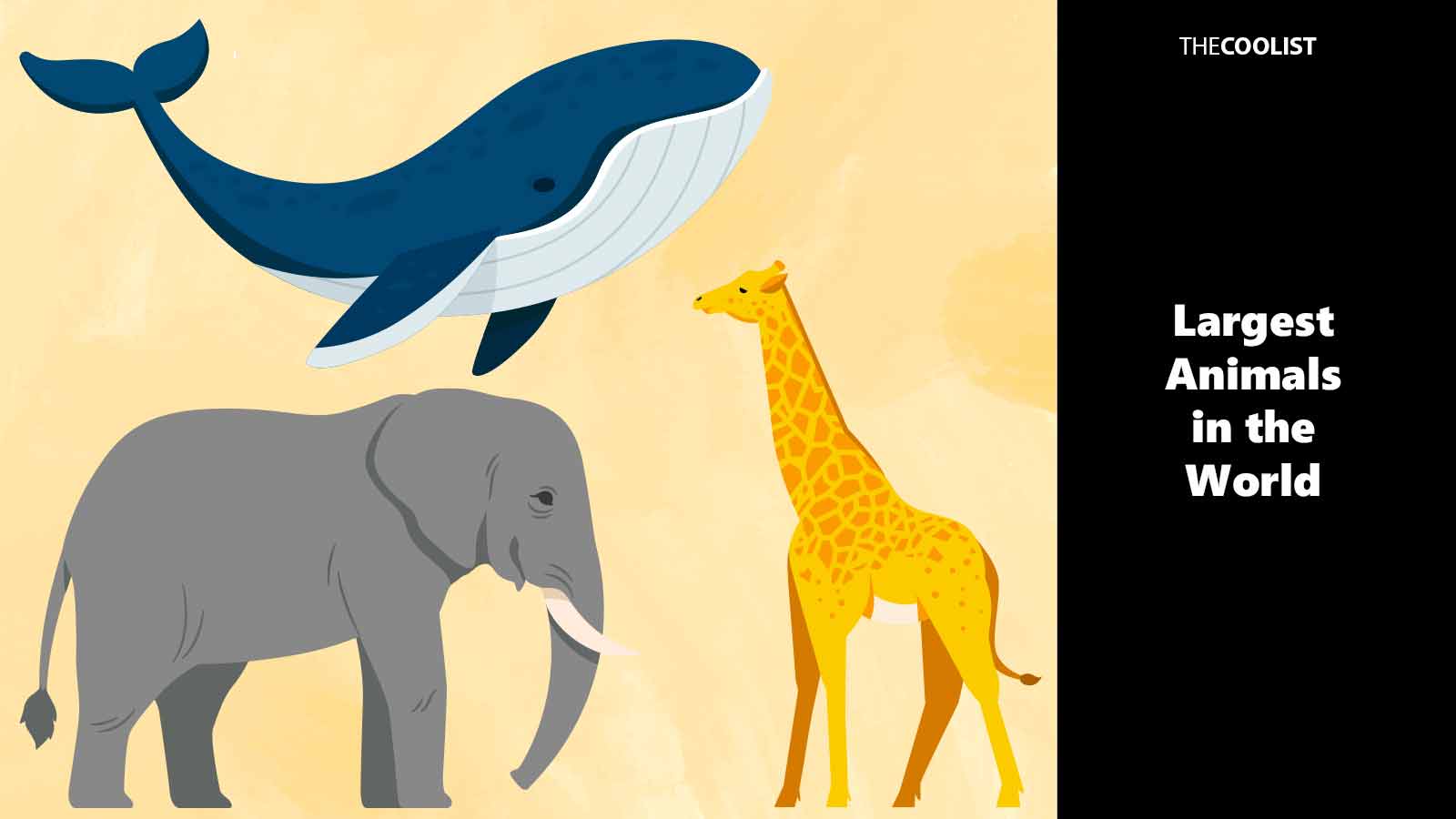
Planet Earth is home to an estimated 8.7 million animal species, of which scientists believe 7.5 million are still undiscovered. From the land to the sea, there is a plethora of species that are unique and worthy of study and attention. Some, such as the ostrich and giraffe are common names we all know, love, and can picture at the merest mention. Otherwise, such as the colossal squid or the Chinese giant salamander are far more niche and spark imaginative discussions of myth and legend.
The world’s largest animals hold a special sway over the collective consciousness of human beings. Their grandeur often sees them occupy unique ecological niches in which only they can succeed, inspiring equal parts awe, respect, and even fear. Towards this end, we describe the biggest animals of their respective type for your enjoyment and wonder below.
- Blue Whale: Largest animal to ever live, up to 100 feet (30 meters) long and over 200 tons.
- Ostrich: Largest bird at nearly 9 feet (2.7 meters) tall and 320 lbs (145 kg).
- Komodo Dragon: Largest lizard at 10 feet (3 meters) long and weighing over 150 lbs (68 kg).
- Whale Shark: Largest fish at 62 feet (18.8 meters) long and 47,000 lbs (21,000 kg).
- Giraffe: Tallest land animal at up to 18 feet (5.5 meters) tall.
- Colossal Squid: Largest invertebrate at 46 feet (14 meters) long and up to 1,100 lbs (500kg).
- Saltwater Crocodile: Largest reptile at up to 23 feet (7 meters) long and 2,200 lbs (1,000 kg) in weight.
- Polar Bear: Largest land carnivore at 1320 lbs (600 kg) and up to 10 feet (3 meters) on hind legs.
- Giant Huntsman Spider: Largest arachnid by leg span, up to 1 ft. (30 cm).
- African Elephant: Largest land animal at 13 feet (4 meters) tall, weighing up to 6.5 tons.
- Green Anaconda: Largest snake at 550 lbs (250 kg) and up to 30 feet (9 meters) long.
- Goliath Beetle: Most massive insect at 3.5 oz (100 grams) and up to 4.3 inches (11 cm) long.
- Chinese Giant Salamander: Largest amphibian at 6 feet (1.8 meters) long and 110 lbs (30 kg).
1. Blue Whale
The blue whale (balaenoptera musculus) is the largest animal to have ever existed on Earth, measuring up to 100 feet (30 meters) from nose to tail. The blue whale dwarfs any creature in recorded history, weighing in at over 200 tons (which is heavier than 30 Tyrannosaurus Rex or 3,000 adult men). It gets its name from its blue-gray body and lighter belly. Despite their titanic size, the blue whale’s diet consists mainly of tiny crustaceans called krill. Blue whales need to eat over 4 tons of krill per day, which they filter from the water through their baleen.
View in gallery
Blue whales are rather solitary creatures who live a nomadic existence. They are found in all of the world’s oceans, however, prefer to stay in deep offshore waters. They are famed for the long distances they travel, which regularly amount to over 4,000 miles a year. Blue whales often partake in extraordinary deep dives, reaching over three hundred meters, and remaining underwater for up to fifteen minutes at a time. The blue whale is a remarkable creature that is neither predator nor prey in the traditional sense of the word. They eat tiny organisms that live in the water, and their young are occasionally attacked by orcas, however, this is not enough to earn them either label.
Blue whales give birth once every two or three years after a twelve-month pregnancy. While they were once hunted, the blue whale is now a protected species. However, they still face threats in the form of climate change and ship strikes. The blue whale is an important factor in the oceanic ecosystem thanks to its nutrient cycling over such large distances.
2. Ostrich
Ostriches (struthio camelus) are the largest and heaviest bird on the planet, measuring up to 9 feet (2.7 meters) tall while tipping the scales at 320 lbs (145 kg). Ostrich eggs measure up to 6 inches and are the comparative size of 24 chicken eggs. Given their size, ostriches have long strong legs and are unsurprisingly flightless birds. Native to the African savanna and desert-like landscapes, the Ostrich is considered a prey animal hunted by several natural predators including cheetahs, lions, and leopards. Ostriches are omnivores and are known to eat insects or other small animals. However, their primary diet consists of plants and seeds.
View in gallery
The ostrich is a remarkable bird famous for its speed, with a top running speed of 45 mph, and is capable of maintaining a speed of between 30 and 35 mph for thirty minutes before needing a break. While not predator animals, their powerful legs deliver a strong and swift kick in self-defense. Female ostriches lay between 10 and 18 eggs per year of which approximately 10% survive the 9-week incubation period.
While a wild species of bird, ostriches are frequently farm-reared for their feathers, skin, and meat. However, their numbers in the wild are strong except for one subspecies, the North African ostrich, which is considered critically endangered. Wild ostriches play a vital ecological role acting as seed dispensers, and also landscape modifiers. The ostrich is also the subject of a prevailing myth that they bury their head in the sand when scared.
3. Komodo Dragon
The Komodo dragon (varanus komodoensis) is the largest lizard on earth, measuring over 10 feet (3 meters) from nose to tail and weighing over 150 lbs (68 kg). With their muscular frame, short powerful limbs, scaly skin, and long tail, the Komodo dragon is a close relative to snakes and cuts an imposing figure deserving of its name. Despite their saurian appearance, Komodo dragons are are not a direct descendant of dinosaurs
View in gallery
A carnivore, the Komodo dragon is considered an apex predator within its ecosystem, preying upon large animals including deer and water buffalo. A solitary creature, the Komodo dragon is native to numerous Indonesian islands including Komodo, Rinca, and Flores. The Komodo dragon is an aggressive and highly territorial lizard with a venomous bite that is potentially fatal to humans but will not harm other Komodo dragons.
Hatched from eggs after a 9-month incubation period, young Komodo dragons spend their early life in the trees, using their strength to leave the ground and avoid being eaten by others of their kind. Overall, the Komodo dragon is an important predator in their ecosystem and plays a vital role in influencing and controlling prey populations. The Komodo is a protected species yet plays a central role in local tourism, with people flocking to see the great lizards in person.
4. Whale Shark
Whale sharks (rhincodon typus) are the largest fish species, growing as large as 62 feet (18.8 meters) from nose to tail. Whale sharks love the warmer waters and are often found around the equator. They are easily identified thanks to their distinctive yellow markings which form a pattern of spots and stripes. The pattern form on their skin is unique and often serves as an identification marker for scientists studying whale shark activity.
View in gallery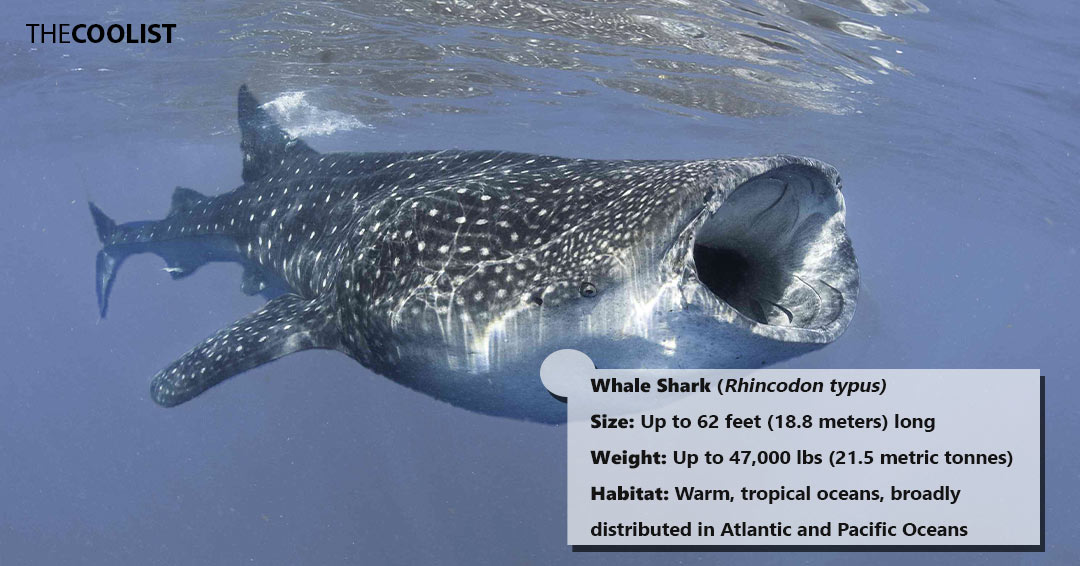
Whale sharks are filter feeders, which means filter large mouthfuls of water through their kills, digesting anything that does not get filtered out. This includes krill and small fish, although their primary food source is plankton. Despite their size, whale sharks are the true gentle giants of the ocean. They follow a vast migratory pattern and are in a lucky category of animals with no natural predators. However, they do face some threats in the form of accidental fishing boat catches.
Whale sharks are wild creatures and none are known to survive or exist in captivity. As a result, a lot is still unknown about these graceful creatures. Scientists know they give birth to approximately 300 live young at a time, and mothers leave their newborns to fend for themselves immediately after birth. However, the gestation period remains a mystery. The whale shark plays a vital role in maintaining plankton levels in the oceans, which, in turn, helps sustain a balanced oceanic ecosystem.
5. Giraffe
Giraffes (giraffa camelopardalis) are recognized as the tallest land animal in the world standing an incredible 18 feet (5.5 meters). An animal the size of a giraffe carries considerable weight, often tipping the scales at as much as 2 tons. Giraffes are easily recognizable both in the wild and in captivity due to their long neck, spindly legs, and striking patterns. Giraffes also have two small horns on their head, but unlike traditional horns, these are covered with fur and are known as ossicones.
View in gallery
Giraffes are native to Africa, particularly the savannas, grasslands, and areas of open woodland. They eat a herbivorous diet, feeding on the leaves of the acacia tree, a tall tree with a striking and recognizable appearance thanks to its twisted trunk and branches. Social animals, giraffes live in open herds usually consisting of related females and their young, or bachelor males. However, giraffes also gather in large multi-herd groupings from time to time.
Female giraffes give birth to a single live young after a 15-month pregnancy. Their young are the most vulnerable to predation from lions and hyenas, however, adults are also known to fall victim. Giraffes are sadly hunted for their meat and skin and face the continued threat of habitat loss due to climate change and growing human populations. The knock-on effect of this impacts the environment as giraffes play a vital role in pollination and seed distribution throughout their habitat.
6. Colossal Squid
The colossal squid (mesonychoteuthis hamiltoni) is the largest of all invertebrates, measuring up to 46 feet (14 meters) and weighing upwards of 1,100 lbs (500kg). The colossal squid lives in the deepest waters of the Southern Ocean. The first live specimen of colossal squid was not caught until 2005, such is the depth at which they live. Colossal squid have the largest eyes in the world, a necessity for parsing their light-starved environment.
View in gallery
Given the infrequent contact between the colossal squid and humans, there is a lot that remains unknown about this underwater behemoth. However, they are believed to be carnivorous, feeding on large fish and other squid. Yet, despite their size, they have one known predator in the sperm whale. The world’s first colossal squid discovery was in the belly of a captured whale.
The lack of overall knowledge about the colossal squid makes it difficult for scientists to say things with much certainty, however, it is safe to assume this large predator plays an important role in deep-sea population control. Nothing is known about the reproductive cycle of the colossal squid, however, scientists again believe that much like other squid species, they die after spawning in an act of natural control over their numbers.
7. Saltwater Crocodile
The saltwater crocodile (crocodylus porosus) is the largest living reptile in the world, measuring up to 23 feet (7 meters) and weighs over 2,200 lbs (1,000 kg). It is the closest living descendent of dinosaurs, and cuts a formidable figure, with a short, squat body, and stocky, powerful legs attached to powerful jaws. Saltwater crocs are native to the brackish and saltwater waters around Southeast Asia, Australia, and parts of India.
View in gallery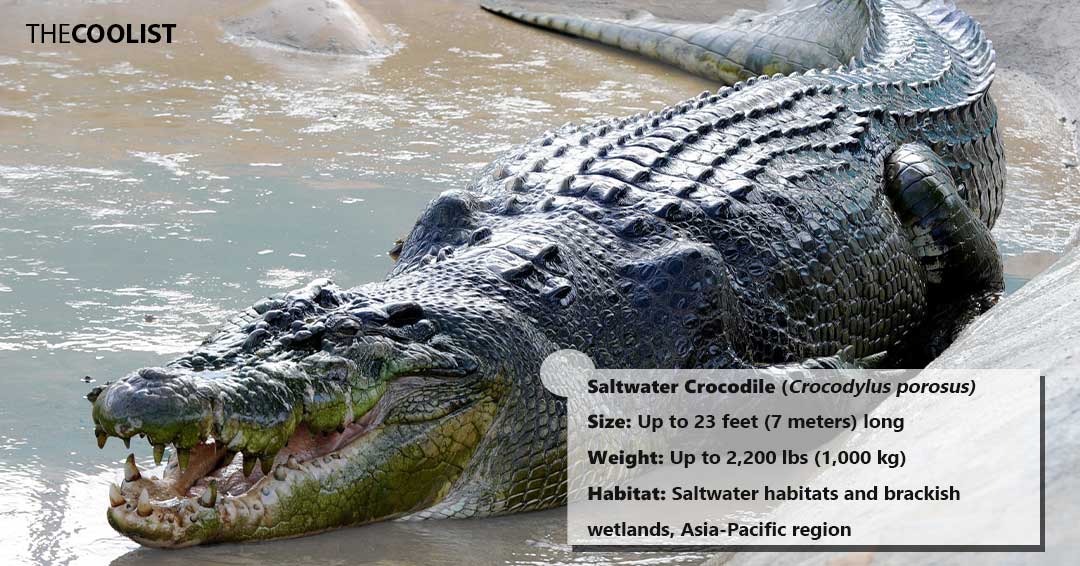
An opportunistic predator, the saltwater croc is known to hunt a variety of prey including fish, birds, and mammals. Everybody has seen the videos of crocs attacking a herd of animals gathered at the water’s edge. The classic predatory style involves the famous ‘death roll’ where the croc twists and rolls its prey, drowning it before feasting on it over time. Salties are highly territorial and as such do not form social groups, yet they are considered social reptiles and will often congregate together nonetheless.
Female saltwater crocodiles lay approximately 50 eggs in each nest per season and will guard them until they are hatched. Once fully grown, the saltwater croc has no natural predators, however, humans still hunt them for their skin in many areas despite strict controls in place to protect them.
8. Polar Bear
Polar bears are the largest land carnivores globally, with males weighing up to 1320 lbs (600 kg) and towering up to 10 feet (3 meters) on hind legs. Their massive size correlates with the incredible strength and endurance that allows them to endure in the harsh Arctic environment. Male polar bears can weigh up to 600 kg (1,320 lbs) and measure up to 3 meters (9.8 ft) in length, whereas females are about half that size. Their distinct white fur, which camouflages them against the ice and snow, and their strong, streamlined bodies enable them to be excellent swimmers, capable of covering distances of over 10 kilometers (6.2 miles) in search of food.
View in gallery
Polar bears are highly specialized predators, primarily feeding on seals. They rely on sea ice to hunt, waiting by seal breathing holes or breaking into their dens. This diet is rich in fat, essential for building the energy reserves they need to survive the Arctic’s extreme conditions. Unlike brown bears, polar bears do not hibernate; only pregnant females dig dens in the snow to give birth and stay there until the spring. A female polar bear typically gives birth to twins, though single or triplet births are not uncommon, and the cubs remain with their mother for over two years, learning crucial survival skills.
Polar bears are solitary animals, with wide-ranging territories. They have a keen sense of smell, enabling them to detect prey nearly a kilometer away. The changing climate poses a significant threat to their habitat, primarily due to the melting of sea ice, which challenges their ability to find food. This has led to increased interactions between polar bears and humans as bears venture closer to human settlements in search of food.
Polar bears play a critical role in the Arctic ecosystem. As apex predators, they help maintain the balance of marine life. Polar bear health and population trends are also indicators of the overall health of the Arctic environment. Conservation efforts are crucial to ensure their survival, addressing threats like climate change and human-induced habitat destruction to protect these majestic creatures of the ice.
9. Giant Huntsman Spider
The giant huntsman spider (heteropoda maxima) is the largest spider in the world, with a leg span up to 1 foot (30 cm). It is pale brown with long legs and a flat body that afford it high agility for hunting. The giant huntsman is native to the cave systems of Laos and is thus highly reclusive, giving it very little interaction with humans.
View in gallery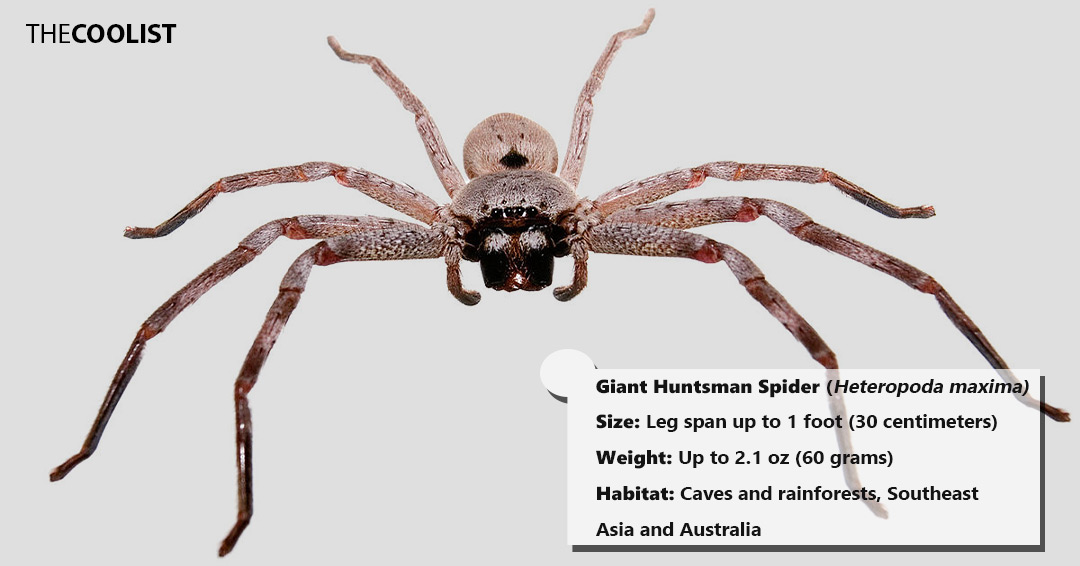
Despite its size, it is highly agile, preying primarily on insects and small invertebrates. However, it is also prey, often hunted by larger animals and even some birds. Unlike most spiders, which hunt using a web, the giant huntsman chases down its prey on foot, utilizing its famous speed to strike.
The female giant huntsman lays up to 200 eggs inside a silk-like sax, which she guards fiercely until they hatch. Females continue to live with multiple generations of their young for up to twelve months and live a surprisingly social lifecycle. Unlike many other siders, males and females show signs of long courtships and no violence before or following mating.
10. African Elephant
The African elephant (loxodonta africana) is the largest living land animal, standing 13 feet (4 meters) to the shoulder and weighing around 6.5 tons. It it is a highly social herbivore native to the African savannas, forests, and deserts, that survives by consuming grass, leaves, tree bark, and fruit. Famous for their large frame, sizable ears long trunk, and ivory tusks, there is no mistaking the African elephant. Unfortunately, these features have attracted the attention of poachers, and as such the African elephant is an endangered species despite the illegality of the ivory trade.
View in gallery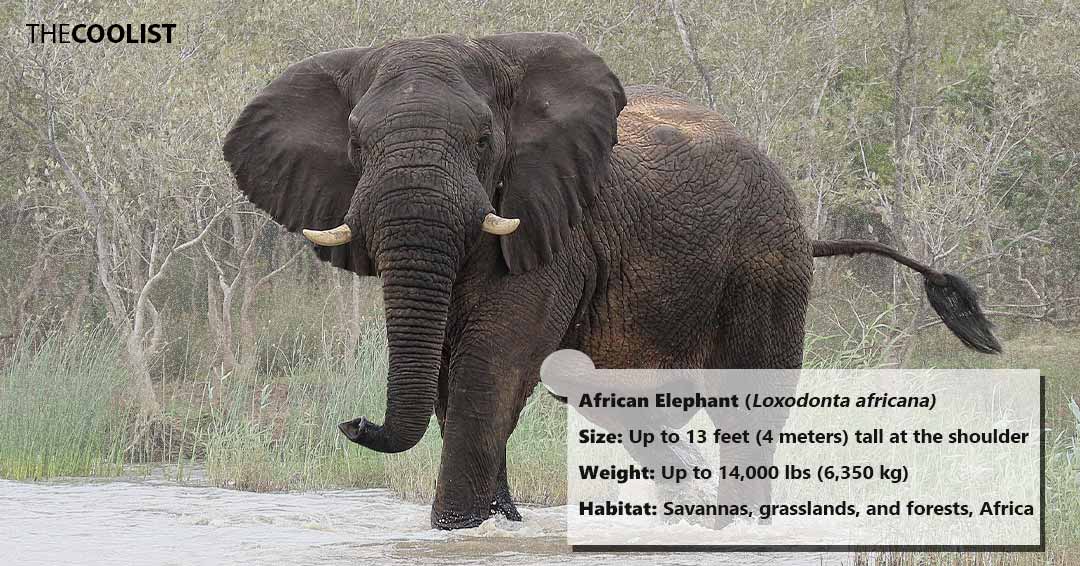
African elephants live in large family groups led by a matriarch. Intelligent and graceful, the African elephant is a majestic animal that has no natural predators due to their size and strength in numbers. Younger calves are the most likely to be attacked by a predatory animal. Female African elephants endure a 22-month pregnancy and give birth to a single calf at a time.
The African elephant is not only a famous figure in the African wilds, but it plays a vital role in ecosystem regulation thanks to its ability to modify landscapes by trampling vegetation or felling trees, to being a viable source of seed dispersal.
11. Green Anaconda
The green anaconda (eunectes murinus) is the world’s heaviest snake, weighing up to 550 lbs (250 kg) with lengths up to 30 feet (9 meters). The green anaconda has a thick green-brown body that sits at around 12 inches across, with black spots and powerful jaws, and a body that can squeeze its prey with the same force as an elephant’s footstep. Its size, power, and overall aspect make it a frequent subject of myths and monster stories.
View in gallery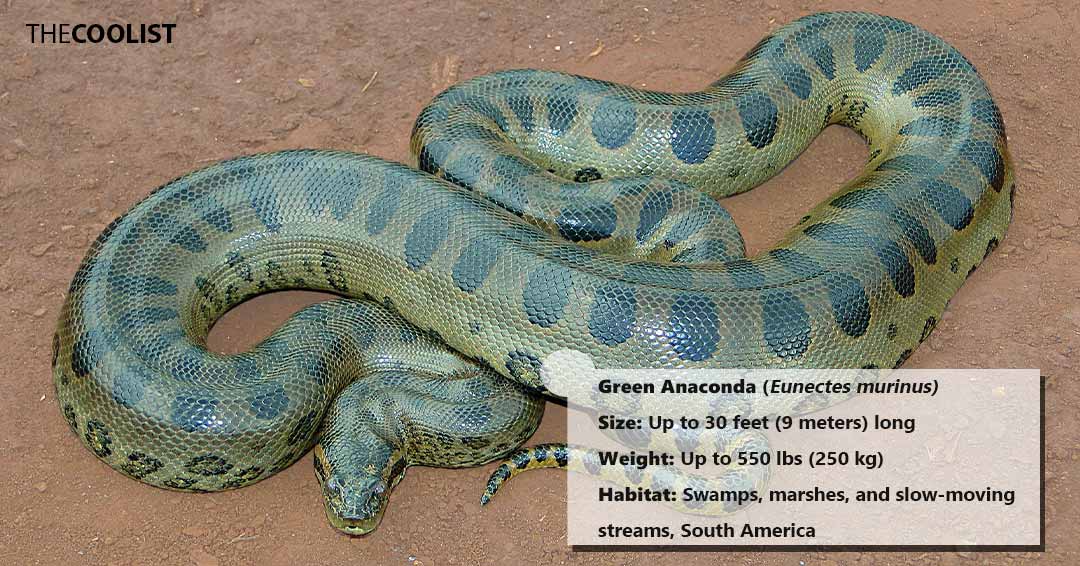
The green anaconda is a strong swimmer that employs the ambush hunting technique to capture its prey. It is native to the swamps, marshes, and slow-moving rivers of South America, and as such the green anaconda has little interaction with humans. Nevertheless, the anaconda is an apex predator hunting fish, birds, mammals, and even caimans. The green anaconda plays an important role in population control of these species within their ecosystem.
Female green anacondas give birth to about 20-40 young at a time following a 6-month pregnancy. Within mere hours of being born, the young anacondas can swim and hunt on their own, catching frogs and small fish without the help of their mother.
12. Goliath Beetle
The Goliath beetle (goliathus) is appropriately named as the most massive beetle species in the world. It can weigh up to 3.5 oz (100 grams), and achieve lengths over 4 inches (11 cm). Native to Africa’s tropical forests, the Goliath beetle is frequently collected and traded by humans and even kept as a pet.
View in gallery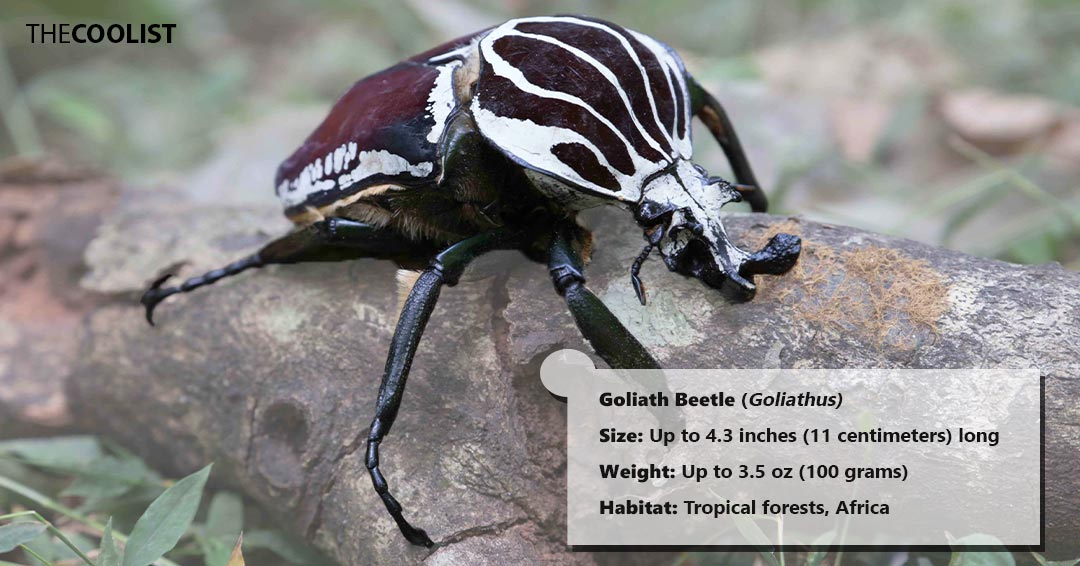
Noted for its distinctive coloration and heavy-set build, the Goliath beetle is as strong as it is large and reported to be able to lift around 850 times its body weight. It is a diurnal feeder that eats plant matter when in the larvae stage and fruit or tree sap when an adult. The Goliath beetle is frequently preyed upon by birds and larger animals.
The female Goliath beetle lays upwards of 50 eggs buried in a pile of rotting wood or damp soil. The eggs take around two weeks to hatch at which point they remain underground for around 4 months before they are fully grown and ready to enter the world. Territorial creatures, adult male Goliath beetles will fight other males that enter their territory.
13. Chinese Giant Salamander
The Chinese giant salamander (andrias davidianus) is the world’s largest amphibian, measuring around 6 feet (1.8 meters) from nose to tail and weighing approximately 110 lbs (30 kg). The Chinese giant salamander has a large broad body with wrinkled skin and spends their entire lives underwater. Yet, despite this, they do not have gills. Rather, the Chinese giant salamander absorbs oxygen through its skin.
View in gallery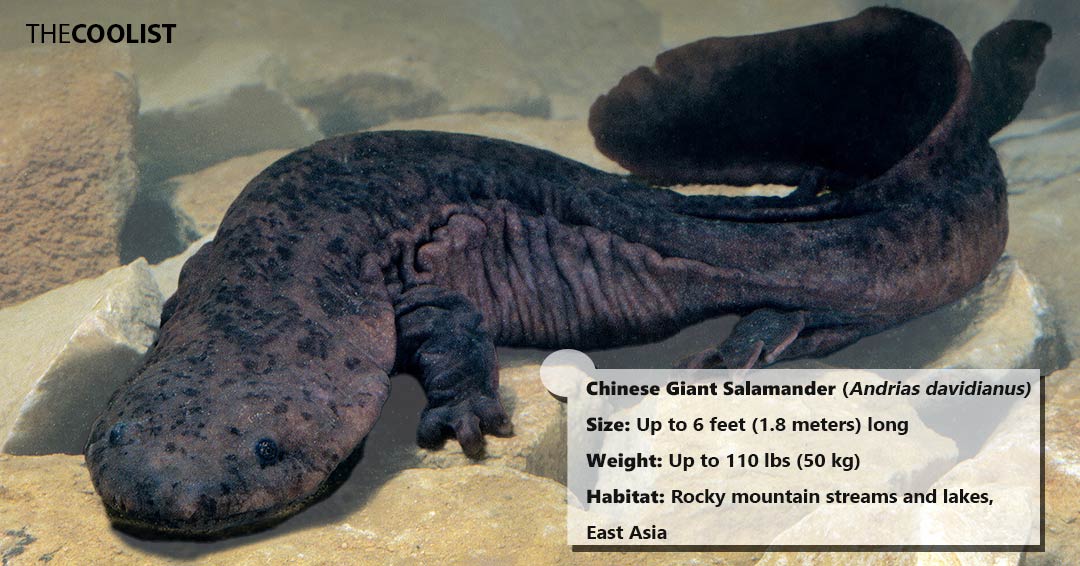
Native to China’s freshwater rivers and streams, this carnivore feeds on fish, worms, and crustaceans. However, they are nocturnal animals and have very poor eyesight, as a result, they hunt based on smell and touch. As such, it is often the subject of illegal hunting or capture for the pet trade.
The Chinese giant salamander breeds in underwater cavities and caves. The female will lay up to 500 eggs at a time, and a male will then fertilize and guard them until they hatch. Natural predators in their habitat, the Chinese giant salamander play an important role in prey population control and maintaining the ecosystem balance.
What is the importance of the environment for large animals?
The environment is important to larger animals for three primary reasons. Firstly, the environment within any given ecosystem supplies sufficient shelter and habitat requirements to sustain the life of that animal. Large animals cannot enter any ecosystem and thrive because of their size. The correct environment must still provide adequate sustenance, shelter, and space to raise the next generation of the species. Secondly, the environment is important for the social and reproductive behaviors of large animals. Depending on the abundance or lack of elements such as water, terrain, food, and vegetation, how species interact, communicate, and breed will be affected. Large animals have evolved and adapted to their respective environments over time. Migration patterns and relocation for reproduction are evident in many species where their day-to-day environment has proven inhospitable for such purposes. These species live across multiple environments driven by their need at the time. Finally, the environment is important to large animals because of its impact on the wildlife’s mental health and emotional well-being. Animals are not much different from people. They suffer from depression and emotional trauma. The environment they live in plays a significant role in regulating their mental health. Species naturally thrive in environments that stimulate their needs and natural behaviors.
Why are large animals important in the environment?
Large animals are important to the environment because they help maintain biodiversity within their ecosystem. Balance plays a vital role in all ecosystems, and that starts with the largest animals, whose grazing habits and predatory behaviors are just two crucial measures by which the biodiversity of their world is maintained. Large animals play a crucial and controlling role in determining the survival and spread of different plant life through their environment, which in turn, impacts which other animals are able to survive in the same ecosystem. The reverse is also important, the vegetation large animals eat and the natural destruction they cause, such as elephants felling trees, creates an opportunity for animals to exist within a particular biome, including the creation of microhabitats. Large animals also support the environment by providing nutrients in the form of feces that help stimulate and sustain natural biological cycles.
How does the behavior of the biggest animals affect the other animals?
There are three primary ways that the behavior of the biggest animals affects other animals. Firstly, large animal behavior has a massive impact on predation and food webs within any particular ecosystem. The bigger animals within an ecosystem or sub-system play a large role in population regulation and thus ensure the natural balance of the food web is maintained. Secondly, large animal behavior exerts behavioral influence on smaller species. Everything from feeding and habits to breeding and even migratory patterns are influenced by the changing behaviors of the larger predators within an ecosystem. Finally, the behaviors of large animals impact those of other animals through ecosystem engineering. The behaviors of large animals such as elephants shape the ecosystem they exist in and thus indirectly create opportunities for smaller animals to thrive. An example would be the movements of elephants to create passageways through dense terrain that smaller creatures would not be able to create.
What are the smartest animals in the world?
Below are the seven smartest animals in the world.
- Rats: Rats are one of the smartest animals in the world and are renowned for their problem-solving abilities and the adaptive memory that allows them to recall the passage through mazes or other route recognition skills.
- Pigs: Pigs demonstrate their intelligence and propensity for learning through their ability to manipulate objects to their advantage. Additionally, pigs have demonstrated a clear ability to understand basic symbolic language.
- Octopus: The intelligence of octopi is well documented. The octopus demonstrates strong problem-solving capabilities along with both short and long-term memory functions marking it as one of the most intelligent species on earth.
- Elephants: An elephant’s intelligence is noted in their self-awareness, demonstrated by their ability to recognize their reflections. Elephants also exhibit complex social hierarchies with strong empathy levels displayed when a member of the herd dies.
- Chimpanzees: The intelligence of chimpanzees is exhibited in their abilities to learn languages and communicate with others and their use of tools and advanced thought processes to solve problems.
- Bottlenose Dolphin: Bottlenose dolphins are recognized for their intelligence not only through their complex communication capabilities and problem-solving skills but also their ability to mimic actions and learn an extensive range of complex instructions.
- Orangutans: Orangutans demonstrate their high intelligence through their ability to use tools and plan for the future, two traits that are indicative of high-functioning intelligence. Additionally, Orangutans are adept problem solvers and learn by observing what has happened and what is happening around them.
What are the heaviest animals in the world?
Below are the seven heaviest animals in the world.
- Polar Bear: Polar bears are large animals that embody the phrase survival of the fittest. With four inches of fat covering their body polar bears are able to survive life in the arctic tundra. Weighing approximately 1750kg they are one of the heaviest animals in the world, and not an animal to be taken lightly.
- Giraffes: Despite their size, Giraffes are rarely talked about for their weight. However, these long-legged graceful animals tip the scales at approximately 2 tons cementing their place as one of the heaviest animals in the world.
- Elephant Seals: The elephant seal gained its name thanks to its trunk-like nose and its gargantuan size. Male elephant seals measure over 20 feet tip to tip and weigh over 4 tons. Bull seals are approximately four times larger than female cows, with one dominant male often having control of up to a hundred females each breeding season.
- Hippopotamus: The hippopotamus lives a semi-aquatic lifestyle, tipping the scales at 4.5 tons. The iconic hippo is not only one of the largest but also deadliest animals on earth, with deceptive speed and a bone-crushing jaw strength.
- Rhinoceros: The beloved rhinoceros deserves recognition as one of the heaviest animals in the world, with the white rhino weighing in at a jaw-dropping 4 and a half tons. However, the black and Javan rhinos weigh considerably less at around 2.5 tons. The famous Indian rhino, with the classic skin folds, comes in at 4 tons.
- Elephant: Elephants are the largest land mammal currently walking the earth. Even the smallest African forest elephant weighs 6 tons, however, it is the male African bush elephant that takes the crown, with a top weight of over 12 tons. Asian elephants split the difference and weigh in at around 8 tons, which means every elephant species has a rightful claim to being the largest land mammal.
- Blue Whale: The blue whale is the largest and heaviest living creature on earth. Measuring up to twenty-four meters and weighing over two hundred tons, there is no other animal that comes close to matching the sheet immensity of the blue whale.
What are the deadliest animals in the world?
Below are the seven deadliest animals in the world.
- Hippopotamus: The Hippopotamus is not an animal most people need to worry about encountering, however, it doesn’t stop them from being one of the deadliest animals in the world. Deceptively fast for their size, with canine teeth that measure around 2 feet long and a bit force twice that of a fully engaged lion, hippos are hardcore creatures.
- Brazilian Wandering Spider: The Brazilian Wandering Spider, native to Brazil measures between five to seven inches across. The spider frequently wanders into populated areas looking for warmth and shelter. A bite from this spider is potent enough to kill a human in two to six hours without medical aid.
- Stonefish: Located in the coastal Indo-Pacific Ocean, the Red Sea, and the Great Barrier Reef and is the most poisonous fish ever discovered. The stonefish injects venom through a spike in its dorsal fin that is potent enough to kill a human in an hour.
- Box Jellyfish: The Box Jellyfish is recognized by the National Oceanic and Atmospheric Administration as the most venomous animal on the planet. Found in the waters around Australia and the Philippines, the box Jellyfish has fifteen tentacles that grow up to ten meters long. Up to 100 people per year are believed to die following a box jellyfish sting.
- Tsetse Fly: The Tsetse Fly measures just 17mm in length but it is responsible for spreading the deadly African Sleeping Sickness. The blood-sucking Tsetse fly is the primary spreader of the disease which is caused by parasites they pass on through their bites. As many as half a million people die each year from the African Sleeping Disease and therefore, indirectly, through the Tsetse Fly.
- Blue-Ringed Octopus: The blue-ringed Octopus is a tiny creature that lives in the Pacific Ocean around Australia and Japan. While only the size of a golf ball, the blue-ringed octopus has a venom that is around a thousand times deadlier than cyanide.
- Mosquito: Mosquitos are smaller than the Tsetse Fly however they are responsible for over 750,000 deaths per year. There are over 3,000 different mosquito species in the world, and many of them carry a range of diseases that affect over 700 million people each year. The most common diseases spread by mosquitoes are Malaria, Chikungunya, Encephalitis, Elephantiasis, Yellow Fever, Dengue Fever, West Nile virus, and the Zika virus,

